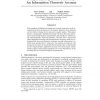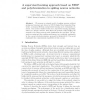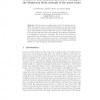15 search results - page 2 / 3 » Spike-timing Dependent Plasticity and Mutual Information Max... |
NIPS
2007
13 years 6 months ago
2007
Reward-modulated spike-timing-dependent plasticity (STDP) has recently emerged as a candidate for a learning rule that could explain how local learning rules at single synapses su...
IJCNN
2007
IEEE
13 years 11 months ago
2007
IEEE
— A spiking neural network model is used to identify characters in a character set. The network is a two layered structure consisting of integrate-and-fire and active dendrite n...
NIPS
2000
13 years 6 months ago
2000
The paradigm of Hebbian learning has recently received a novel interpretation with the discovery of synaptic plasticity that depends on the relative timing of pre and post synapti...
ESANN
2007
13 years 6 months ago
2007
We propose a network model of spiking neurons, without preimposed topology and driven by STDP (Spike-Time-Dependent Plasticity), a temporal Hebbian unsupervised learning mode, biol...
ICANNGA
2007
Springer
13 years 10 months ago
2007
Springer
We developed a computational model of the mushroom body (MB), a prominent region of multimodal integration in the insect brain, and tested the model’s performance for non-element...



